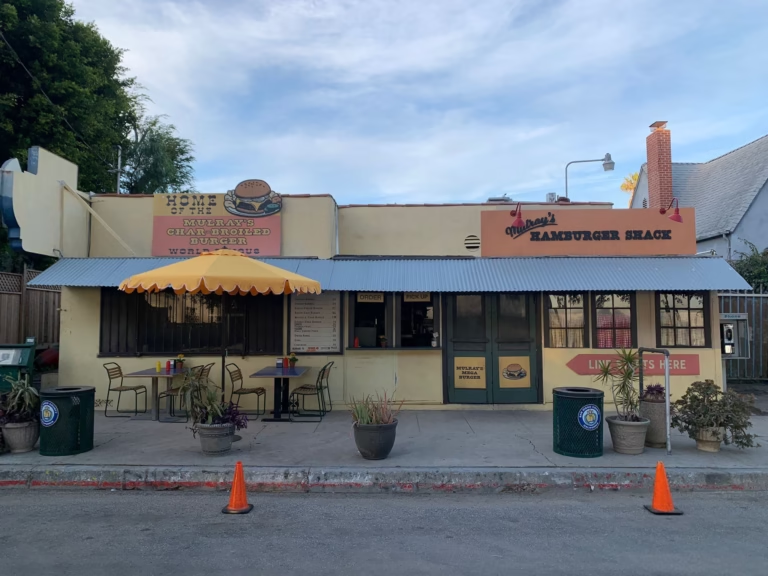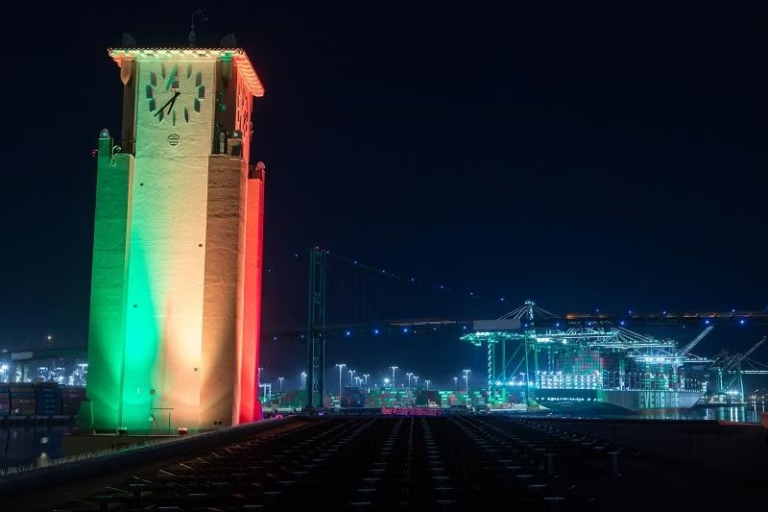When I sat down with a quartet of Garage Theatre co-founders in 2010 as they got ready to celebrate their 10th anniversary, they told me that nearly three times as many groups were doing theatre in Long Beach as when the Garage came on the scene.
But that trend has reversed, and in 2025 you can count on your fingers the number of groups that don’t have “high school” in their name offering theatre of any kind in the 44th biggest city in the United States.
But 25 years on, the Garage Theatre endures. Ask this little engine that could how they can, and they’ve got a word for you: community.
***
The Garage Theatre community started to come together in 1995 when Eric Hamme met Jamie Sweet and Jeff Kriese at Orange Coast College, a conducive environment for DIY drama nerds.
“In addition to the classes and mainstage shows, they had the OCC Rep, which was basically a student-run theatre company,” Hamme relates. “[…] You had to do everything yourself, so it wasn’t uncommon for me to be directing a show, acting in two shows, running lights for one show…. If you needed a set piece, it was like: go to the shop and build it.”
The trio quickly found themselves kicking around the idea of forming their own company, but it was when the three transferred to Cal State Long Beach — “and met much more talented people” (Hamme) — that the Garage really started to happen.
Jessica Variz was among those talents. Kristal Greenlea. Amy Louise Sebelius. And Matthew Anderson, who landed in the CSULB’s Theatre Department straight from Minnesota. When Sweet directed him in a production of David Mamet’s The Revenge of the Space Pandas, Anderson saw a window opening on a possible future: “I felt like we could do this again and again and again and again. All of the pieces were there. It was so much fun, so irreverent…. It just felt so good.”
Immediately after graduation, Anderson, Hamme, and Sweet drove to Washington to see Phish for the first time. It was an epiphany.
“I had never experienced live music in such a way where it felt like the audience was a part of the experience instead of just watching something unfold in front of them,” Anderson recalls raptly. “[…] All of my prior experiences felt like you were going to a concert show or going to a play and watching something. [But at the Phish show] there was a give-and-take, like the audience was feeding what was happening onstage and vice versa. That imaginary fourth wall was just really blurry.”
Many such road trips followed (these are real live Phisheads, kids), as much for the inspiration and camaraderie as for the music.
“Cultivating that connection through the art we were presenting felt like the only thing that was worth pursuing,” Hamme says. “[…] Lots of conversations about shows we wanted to do came on the road driving 12 hours in the middle of night. That solidified the relationship of us as friends and us as a company.”
The Garage Theatre debuted in 2001 with Eric Bogosian’s Scene from the New World at Studio 354, a club known for Monday-night keggers where a ten-spot got you live music and all you could drink. But one week into the Garage’s second show Studio 354 was shut down (Hamme: “It was totally illegal”), and during the next four years the Garage performed kinda wherever they could (including once in the Santa Ana digs of fellow OCC spinoff Rude Guerilla (RIP)) and averaged only two shows a year.
Yet to their surprise, they had a bit of a following.
“I remember in grad school [hearing] that theatres were desperately trying to capture that 18-34 demographic because theatre is expensive and it gets perceived as a little elitist,” Hamme says. “But from Day One we had it. […] We tried to market ourselves as theatre for people who don’t like theatre. We encouraged people to bring their own beer and wine to the show. […] We were just trying to do stuff our friends would like. We didn’t [yet] know or have a relationship with the greater Long Beach community, so we just said, ‘Well, we like it — and if our friends give us the thumbs-up: success!’”
But it was after their 2005 move into “the space” at 251 E. 7th Street — made available when the Found Theatre (RIP) decamped for new digs across the street at the City Place Shopping Center — that they first felt like a full-fledged theatre company. And with it, the added pressure.
“We knew we had to pay rent now,” says Hamme, “so it was just: show show show show” — eight in 10 months, which they realized wasn’t a sustainable model creatively. By 2007 they’d hit their stride, doing six shows including a Mamet, a Sebelius autobiographic that was a local sensation, the third installment of Sweet’s five-play melodrama/farce, and a staging of Don DeLillo’s Valparaiso (the set was a box without walls tricked out in lo-fi multimedia) that convinced me they definitely had something going on.
The next several years were relatively smooth sailing, as they joyfully navigated everything from The Threepenny Opera and Richard III to The Last Days of Judas Iscariot and Trey Parker & Matt Stone’s Cannibal! The Musical — all while regularly being voted Long Beach’s fave arts organization. Original projects were regularly in the mix, such as 2011’s monumental LOLPERA, whose libretto was composed exclusively of LOLcat memes and hilariously dramatized the catastrophe inherent to a world where the search for meaning in life has been commodified into the most meaningless of pursuits.
But communities change. Kriese left in 2008, and by 2013 Sebelius, Greenlea, and Variz had followed. That year the Garage merged with (ingested?) Alive Theatre, a younger spawn of CSULB’s Theatre Arts program. Although results of the partnership were mixed (“We’ve done some stinkers for sure,” laughs Hamme, ticking off a few examples both pre- and post-merger), one of the two Alivers still with the Garage today is Thomas Amerman, who — along with Garage mainstay and set designer Rob Young — is chiefly responsible for tending the flame of one of the Garage’s most charming traditions: how for each show the interior is transformed so that at least a little (and sometimes a lot — even the seats and stage may be in totally different places) it feels like you’ve never been in that particular space.
And some of the Garage’s best work was to come. A peak was 2015’s world-premiere staging of Tom Stoppard’s radio play Darkside, which fashions a narrative from both the music and themes of Pink Floyd’s Dark Side of the Moon. Conceived and directed by Hamme, the result was so well regarded that Stoppard sent a representative from England to check it out. How often does something like that happen to a theatre that rarely has seating for 40?
But by 2018 the waters were choppy. Sweet was gone, leaving Hamme and Anderson the last co-founders standing. And while the lack of a rigid hierarchy wasn’t a problem with the original crew, now the pair’s lack of feel for helmsmanship left the Garage a bit rudderless. There were only three productions that year (including a restaging of Darkside) and just two in 2019 (though one, a parody version of the Patrick Swayze flick Road House, was one of the funniest things they’ve ever done).
Knowing they were adrift, Hamme and Anderson resolved to get a better grip on the tiller. But smack dab in the middle of the 2020 opener came the tsunami known as COVID-19. Not only was the Garage’s 20th washed away, but if they weren’t sinking, they were sure taking on a lot of water. Attention, passengers: in an emergency your seat cushion can be used as a floatation device.
“We had a little bit of money in the bank, but we really depend on that first show to get us through the rest of the year,” Hamme says. And while “a sizeable donation from a family friend” meant they could pay rent on the space for the short term, the nonprofit, all-volunteer Garage (no employees, no payroll) qualified for very little COVID financial assistance and ultimately got none.
So they turned to community. And their community came through.
“In general asking for money has always been an uncomfortable thing for us,” Hamme says. “And let’s be honest: [although] our audience is incredible — I think we have the best audience in Long Beach, and they’re very supportive — we don’t have the wealthiest audience. […] We thought $5,000 [was enough] to get us a few months into 2021. But then we decided, ‘Look, if we’re going to ask for anything, let’s go big.’ And the response was absolutely incredible.”
Despite setting a target of $10,000, the Garage’s “Yes We Can” fundraiser brought in about $25K, which enabled the Garage to pay 2021’s rent in one lump sum.
“I remember thinking, ‘Shit, this actually means something to people,’” Hamme reflects. “Because when you’re in your own little corner of the sandbox just doing your thing, you don’t really think of that; you’re just trying to entertain the people who chose to be there that night.”
“Lots of donations came with stories and experiences that people shared about what we meant to them, how our being there has helped them,” Anderson adds. “It solidified for us our place in the hearts of the community.”
And community was always the goal.
“No matter what year, no matter what the show, when you walk into our space, whether you’ve been there two times or 20, you feel it,” Anderson says. “That’s part of the reason you’re there: that connection, that relationship. Whether you know us or not, you feel like you’re a part of something. And you are.”
***
While in the midst of working on promos for the Garage’s 25th Season kickoff event, Hamme made the mistake of leaving both his laptop and backup drive together in his car overnight. In the morning he was greeted with the broken window, the missing backpack. A record of the last quarter-century in a little corner of Long Beach, gone.
“I called Eric after I got back [from vacation recently], and he said, ‘It’s gone, everything’s gone,’” Anderson says. “But how do you measure something that’s living and breathing? Experience is the thing. Yes, the record of it is gone, but you never really could go back and revisit the experience itself, anyway.”
Twenty-five years on, there’s no end in sight for the Garage. In fact, 2025 is their first five-show season since 2016. And co-founder Jessica Variz — who brilliantly directed Cannibal! The Musical and LOLPERA — is back for a show this autumn.
“We didn’t think it would last 25 years,” Hamme says. “But we just keep doing the work. […] Everyone — even Matt and me — has a last day with the company coming. I’d like for it to go on even after the two of us are gone; but if/when it’s meant to stop, it’ll stop. [In that case] I think it would be cool if there’s just a little plaque at the space that says something like, ‘This shit happened here.’ That’s enough.”
This shit here continues Friday when the Garage Theatre opens its 25th season with the world premiere of Ryan McClary’s Tragedy Gift Shop (dir. Matthew Anderson). For tickets and all things Garage Theatre, visit thegaragetheatre.org.



















